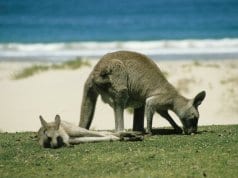Victoria Falls National Park is located on the southern and eastern banks of the Zambezi River, near the Zimbabwe-Zambia border. Victoria Falls National Park isn’t terribly large – most of the park surrounds Victoria Falls. However, when combined with the neighboring Zambezi National Park, the parks represent more than 56,000 hectares of protected habitat.
Most visitors who make their way to Victoria Falls National Park are only interested in seeing the region’s iconic waterfalls, but there are also a number of incredible wildlife species you can observe in the area. We’ll discuss some of the most notable species and provide tips for maximizing your viewing opportunities below.
Hooved Animals
A few antelope species and their relatives dwell within Victoria Falls National Park
Like most other African parks, Victoria Falls National Park is home to a variety of hooved animals. Elands are some of the most commonly seen hooved animals in the park, but a variety of other antelopes – including waterbuck and impalas – also dwell within the park’s boundaries.

Zebras are another commonly seen hooved animal in the park. And thanks to their bold coloration and tendency to form large herds, they’re often quite easy to spot amid the surrounding habitat.
All of these herbivores typically spend most of their time in open areas. This allows them to feed on grasses and see predators coming from long distances. However, the waterbuck – as its name implies – is primarily found in close proximity to water.
Reptiles of the River Valley
Several reptiles – including one of the world’s largest – live within the park.
Africa is home to an array of fantastic reptile species, and many of them live in the vicinity of Victoria Falls National Park. This includes commonly seen species, such as the appropriately named common flat lizard and East-African spiny-tailed lizard. A variety of gecko species also live in the region, including the Zambezi thick-toed gecko, Okavango dwarf gecko, and the Transvaal gecko.

A number of snakes also live in or around Victoria Falls National Park. This includes a number of non-venomous species, such as the Cape house snake, which preys on snakes, lizards and rodents. But it also includes venomous species, such as the Berg adder.
However, the most spectacular reptile that calls Victoria Falls National Park home is undoubtedly the Nile crocodile. Widely considered the second-largest crocodile in the world, the Nile crocodile reaches lengths in excess of 16 feet and weights of up to 1,600 pounds. Nile crocodiles feed on a variety of prey. This includes fish and invertebrates as well as large hooved animals, including wildebeests and zebras.
Rare Sightings: Giants of Victoria Falls National Park
Visitors occasionally have the chance to see a few members of the “big five” when visiting the park.
Visitors don’t see large animals very often in Victoria Falls National Park; they’re more common in some of the other parks of the region. Nevertheless, large animals do move through the park from time to time, so it is wise to keep an eye out for them and have your camera at the ready.

The largest and most celebrated large animal that occasionally moves through the park is the African elephant. However, visitors may spot Cape buffalo, giraffes and southern white rhinoceroses from time to time as well. Hippopotamuses dwell within the Zambezi River and the local tributaries. So, you may have the chance to see them too.
Just be sure that you keep your distance from any of these animals, should you have the chance to see them. While they are all herbivores, who subsist on plants rather than animals, they can also be quite dangerous if they feel threatened.
Wildlife Viewing Tips
Try to incorporate the following tips, as it’ll make your trip more enjoyable.
If you go to all the trouble of visiting Victoria Falls, you’ll certainly want to make sure you see as many animals during your visit as possible. Just try to implement the following tips and tricks, and you’ll likely have the chance to see an array of species.
- Get out early. The temperatures can soar during the middle of the day in the Victoria Falls area, which will tend to depress wildlife activity. But you can work around this by getting out early before the sun is high in the sky and the temperatures have risen.
- Take advantage of the guides available. Victoria Falls visitors will have access to a number of guided safaris, so be sure to consider joining one. The tour guides and safari operators are far more familiar with the local species than visitors are. They also know the best places to spot many of the park’s native species. This means they can often help you see many more animals than you otherwise would.
- Bring a good pair of binoculars. Many of the animals you’ll have the chance to see at Victoria Falls National Park will tend to keep their distance from people. This can make spotting them difficult. But if you bring along a good pair of binoculars, you’ll be able to see them as well as you could if they were standing a few feet away.

Share Your Experiences!
Victoria Falls National Park may not be as large or as famous as nearby Zambezi National Park. But, it is still a remarkable destination, which wildlife lovers should take the opportunity to visit. Not only will you get the chance to see Victoria Falls up close, you’ll also have the chance to see a variety of wildlife species too.
Have you ever visited Victoria Falls National Park? We’d love to hear about your experiences. Let us know what you saw during your trip and share any tips or tricks you may have learned while you were visiting.














![Red Angus Closeup of a beautiful Red Angus cowPhoto by: U.S. Department of Agriculture [pubic domain]https://creativecommons.org/licenses/by/2.0/](https://animals.net/wp-content/uploads/2020/03/Red-Angus-4-100x75.jpg)

